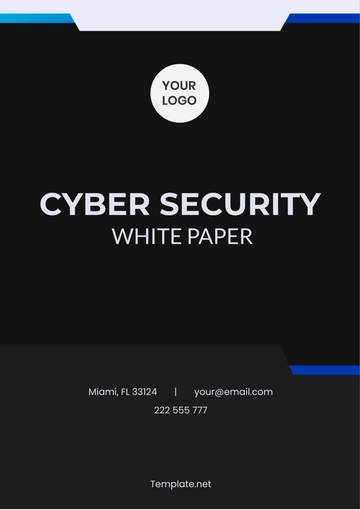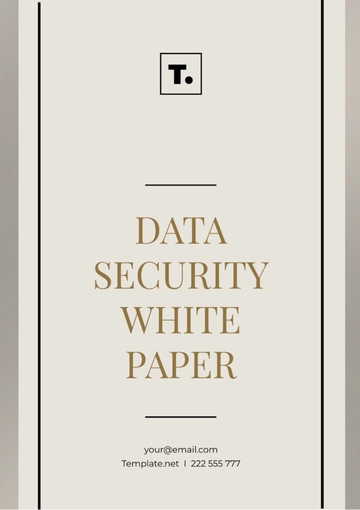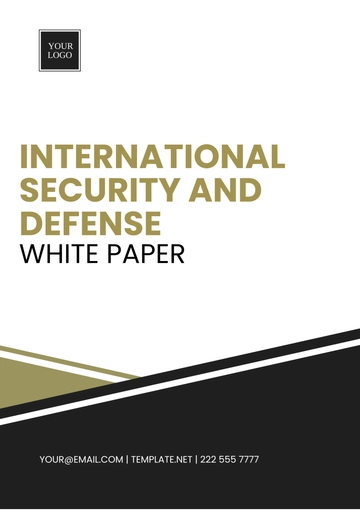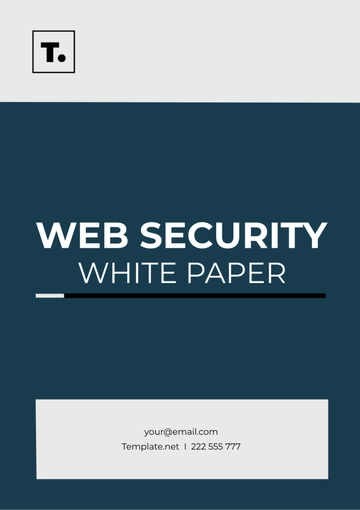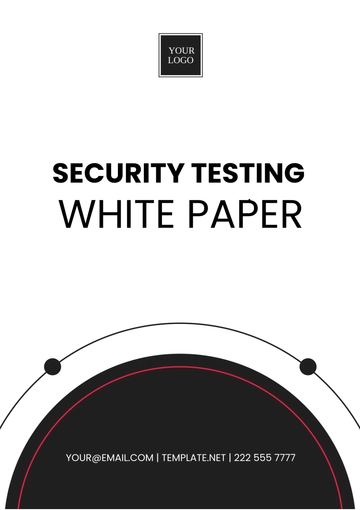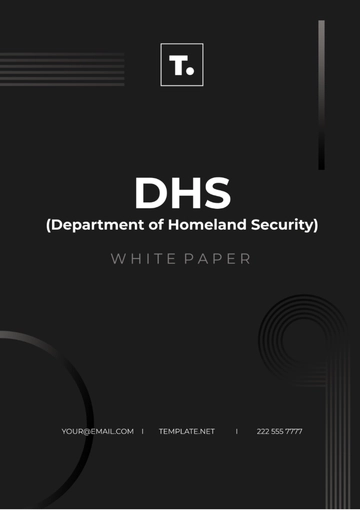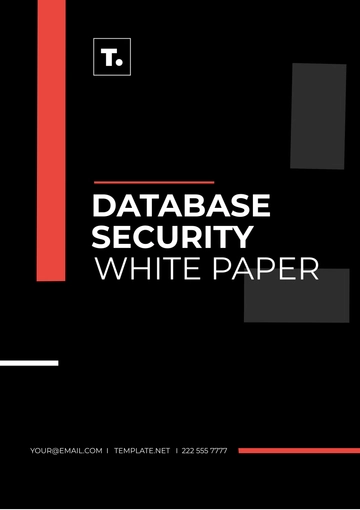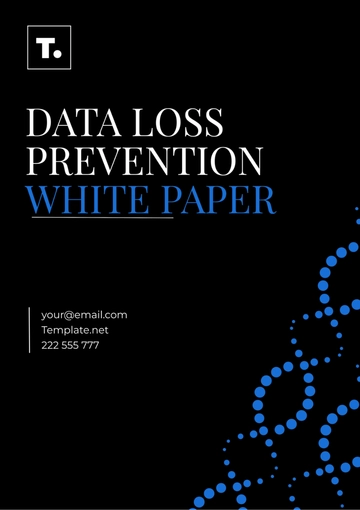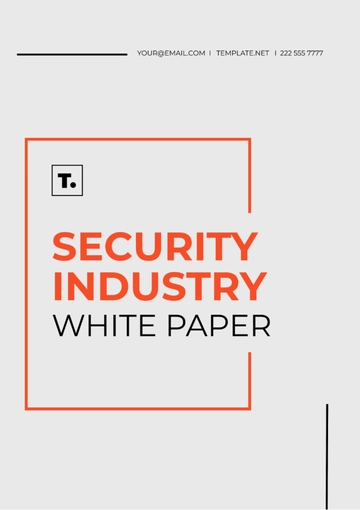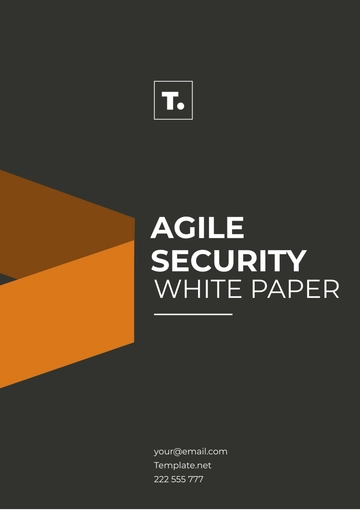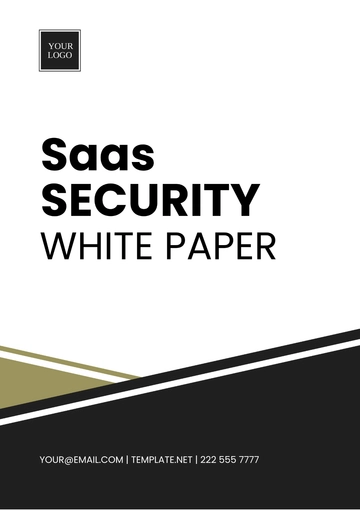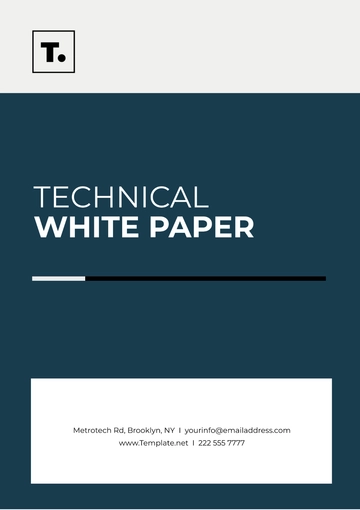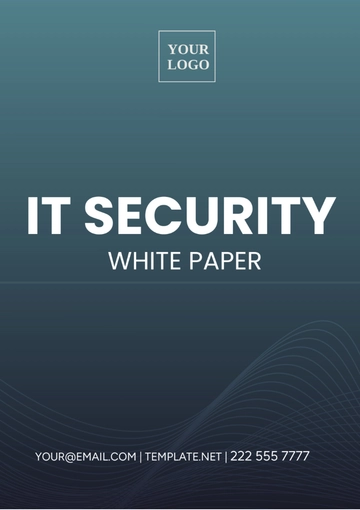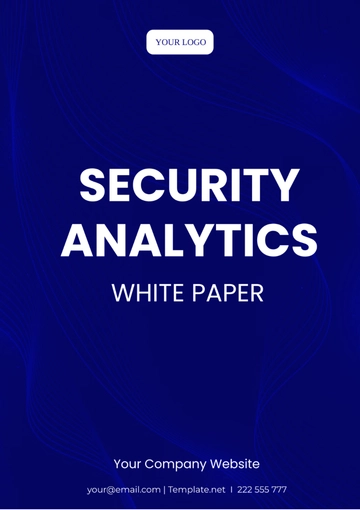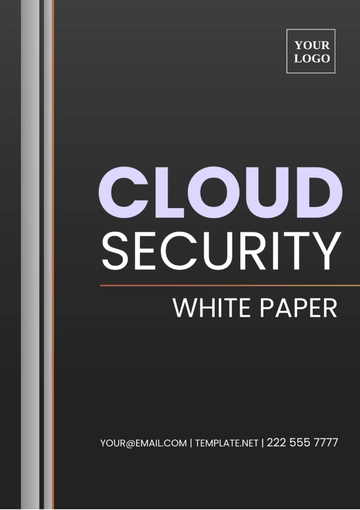Free Security White Paper

Strengthening Cybersecurity: A Comprehensive Guide
By: [YOUR NAME]
Company: [YOUR COMPANY NAME]
Department: [YOUR DEPARTMENT]
Date: [DATE]

I. Introduction
In the digital age, security is not just a necessity; it's a strategic imperative. From safeguarding sensitive data to protecting critical infrastructure, organizations face an array of cybersecurity challenges. This Security White Paper serves as a comprehensive guide to educate stakeholders about prevalent security risks and best practices for mitigating them effectively.
II. Understanding Security Risks
A. Overview of Cyber Threat Landscape
Cyber threats are constantly evolving, posing significant risks to organizations worldwide. Understanding the diverse landscape of cyber threats is essential for developing robust defense strategies.
1. Types of Cyber Threats
Malware: [Malware], such as viruses, worms, and Trojans, pose a significant threat to data integrity and system functionality.
Phishing Attacks: [Phishing] emails and websites aim to deceive users into providing sensitive information, leading to identity theft and fraud.
Ransomware: [Ransomware] encrypts files or systems, demanding payment for decryption, causing severe disruptions to business operations.
Insider Threats: [Insider Threats], intentional or unintentional, can compromise data security from within the organization.
2. Examples of Recent Cyber Attacks
Graph Title: cyber attack incidents:
B. Common Vulnerabilities
Identifying and addressing common vulnerabilities is paramount in strengthening defenses against cyber threats.
1. Identification of Common Vulnerabilities
Unpatched Software: Failure to apply security patches leaves systems vulnerable to known exploits.
Weak Passwords: Inadequate password practices, such as using easily guessable passwords, expose accounts to unauthorized access.
Lack of Encryption: Failure to encrypt sensitive data increases the risk of data breaches and unauthorized disclosure.
2. Examples of Vulnerabilities in Different Systems
I can certainly help you create a table illustrating common vulnerabilities across different systems and platforms. Here's a basic example to get started:
Vulnerability | Android | Windows | IOS | MacOS |
|---|---|---|---|---|
Buffer Overflow | ✓ | ✓ | ✓ | ✓ |
SQL Injection | ✓ | ✓ | ✓ | ✓ |
Cross-Site Scripting | ✓ | ✓ | ✓ | |
Cross-Site Request Forgery | ✓ | ✓ | ✓ | ✓ |
C. Emerging Threats
Stay ahead of emerging threats to proactively mitigate potential risks to your organization's security posture.
1. Emerging Cyber Threats
AI-Powered Attacks: Increasingly sophisticated AI algorithms enable cybercriminals to automate and personalize attacks, challenging traditional defense mechanisms.
IoT Vulnerabilities: The proliferation of Internet of Things (IoT) devices introduces new attack surfaces and potential entry points for cyber threats.
Supply Chain Compromises: Attacks targeting third-party vendors and supply chain partners can have cascading effects, compromising the security of interconnected networks.
2. Potential Impact of Emerging Threats on Organizations
Graph Title: Projected impact of emerging threats on organizational security over the next five years
III. Best Practices for Security
A. Access Control
Implement robust access control measures to limit unauthorized access to sensitive information and systems.
1. Importance of Access Control Measures
Principle of Least Privilege: Grant users only the permissions necessary to perform their job functions, minimizing the risk of privilege escalation.
Multi-Factor Authentication (MFA): Enhance authentication processes by requiring multiple forms of verification, such as passwords, biometrics, and one-time codes.
2. Best Practices for Implementing Access Controls
Role-Based Access Control (RBAC): Assign permissions based on users' roles and responsibilities to enforce security policies consistently.
Regular Access Reviews: Periodically review user access rights to ensure alignment with organizational policies and identify unauthorized access attempts.
B. Data Encryption
Employ encryption protocols to protect data both at rest and in transit, safeguarding it from unauthorized access or interception.
1. Explanation of Data Encryption Techniques
Symmetric Encryption: Uses a single encryption key to encrypt and decrypt data, suitable for securing data at rest.
Asymmetric Encryption: Utilizes a pair of public and private keys for encryption and decryption, facilitating secure communication over insecure channels.
2. Importance of Data Encryption in Protecting Sensitive Information
Graph Title: Percentage of Organizations that use Data Encryption to protect sensitive information.
C. Regular Security Audits
Conduct regular security audits and assessments to identify vulnerabilities, assess risks, and ensure compliance with industry standards and regulations.
1. Benefits of Conducting Regular Security Audits
Proactive Risk Management: Identify and address security weaknesses before they can be exploited by malicious actors.
Regulatory Compliance: Demonstrate compliance with industry regulations and standards through comprehensive security audits.
2. Steps Involved in Performing Security Audits
Certainly! Here's a mock checklist outlining the steps involved in conducting a comprehensive security audit:
Security Audit Checklist
1. Pre-Audit Preparation:
Define audit objectives and scope.
Identify key stakeholders and establish communication channels.
Review relevant policies, procedures, and regulatory requirements.
Obtain necessary authorization and access permissions.
2. Documentation Review:
Gather documentation related to IT infrastructure, network architecture, and security protocols.
Evaluate existing security policies, procedures, and incident response plans.
Review previous audit findings and remediation efforts.
3. Risk Assessment:
Identify potential security risks and vulnerabilities.
Assess the likelihood and potential impact of identified risks.
Prioritize risks based on severity and organizational impact.
4. Technical Testing:
Conduct vulnerability scans and penetration testing to identify weaknesses in systems and networks.
Test security controls, including access controls, encryption mechanisms, and intrusion detection systems.
Validate compliance with industry standards and best practices.
5. Physical Security Assessment:
Inspect physical security measures, including access controls, surveillance systems, and environmental controls.
Evaluate the security of data centers, server rooms, and other critical infrastructure facilities.
Identify potential weaknesses in physical security defenses.
6. Interviews and Observations:
Conduct interviews with key personnel, including IT administrators, security officers, and employees.
Observe security practices and behaviors in real-world scenarios.
Solicit feedback and insights from stakeholders regarding security concerns and challenges.
7. Documentation of Findings:
Document audit findings, including identified risks, vulnerabilities, and areas of non-compliance.
Provide detailed descriptions of findings, including evidence and supporting documentation.
Classify findings based on severity and prioritize remediation efforts.
8. Report Preparation:
Compile audit findings into a comprehensive audit report.
Include an executive summary, detailed findings, recommendations, and action plans.
Ensure clarity, accuracy, and relevance in reporting to facilitate decision-making and remediation efforts.
9. Presentation and Review:
Present audit findings to key stakeholders, including senior management and relevant departments.
Facilitate discussions on findings, recommendations, and proposed action plans.
Obtain feedback and validation on the audit report before finalization.
10. Follow-Up and Monitoring:
Track progress on remediation efforts and action plans.
Conduct periodic reviews and assessments to monitor security posture improvements.
Update security policies, procedures, and controls based on lessons learned from the audit process.
D. Employee Training
Educate employees about security best practices to mitigate human error risks and enhance overall security posture.
1. Importance of Employee Training in Cybersecurity
Human Firewall: Empower employees to recognize and respond to security threats effectively, reducing the likelihood of successful attacks.
Phishing Awareness: Train employees to identify phishing emails and avoid falling victim to social engineering attacks.
2. Topics to Cover in Cybersecurity Training Programs
Password Hygiene: Encourage the use of strong, unique passwords and password managers to protect accounts from unauthorized access.
Secure Remote Work Practices: Provide guidance on secure remote work practices, including the use of VPNs and secure Wi-Fi networks.
E. Incident Response Plan
Develop a comprehensive incident response plan outlining procedures for detecting, responding to, and recovering from security incidents promptly.
1. Development of an Incident Response Plan
Incident Identification: Establish processes for detecting and categorizing security incidents based on severity and impact.
Response Coordination: Define roles and responsibilities for incident response team members and establish communication channels for timely coordination.
2. Steps to Follow During a Security Incident
Detection
Identify signs of a security incident, such as unusual network activity, system alerts, or reports from users.
Utilize intrusion detection systems, security monitoring tools, and anomaly detection techniques to detect potential security breaches.
Analysis
Gather and analyze evidence to determine the scope and severity of the security incident.
Assess the impact of the incident on systems, data, and operations.
Identify the root cause of the incident and any vulnerabilities exploited by the attacker.
Containment
Isolate affected systems or networks to prevent further spread of the incident.
Implement temporary security measures to contain the damage and limit the attacker's access.
Disable compromised accounts, services, or applications to prevent unauthorized activity.
Eradication
Remove malicious components from affected systems, such as malware, backdoors, or unauthorized users.
Patch vulnerabilities and security weaknesses exploited during the incident to prevent future attacks.
Conduct thorough system scans and integrity checks to ensure that all traces of the incident have been eradicated.
Recovery
Restore affected systems, data, and services to their pre-incident state.
Implement backups and disaster recovery plans to recover data and minimize downtime.
Verify the integrity and functionality of restored systems before resuming normal operations.
Lessons Learned
Conduct a post-incident review to identify lessons learned and areas for improvement.
Document the incident response process, including successes, challenges, and lessons learned.
Update incident response plans, policies, and procedures based on insights gained from the incident.
IV. Case Studies
A. [Case Study 1: Company A's Security Breach]
Description of the security breach
Impact on the organization
Lessons learned and improvements made
B. [Case Study 2: Successful Implementation of Security Measures at Company B]
Overview of security measures implemented
Positive outcomes and benefits experienced by the organization
V. Conclusion
 In conclusion, prioritizing security is not merely an option—it's a business imperative. By understanding prevalent risks and adopting best practices outlined in this Security White Paper, organizations can fortify their defenses and safeguard against evolving cyber threats. Remember, proactive measures today can prevent costly breaches tomorrow.
In conclusion, prioritizing security is not merely an option—it's a business imperative. By understanding prevalent risks and adopting best practices outlined in this Security White Paper, organizations can fortify their defenses and safeguard against evolving cyber threats. Remember, proactive measures today can prevent costly breaches tomorrow.
VI. About [Your Company Name]
[Your Company Name] is a trusted leader in cybersecurity solutions, dedicated to empowering organizations with robust defense strategies and innovative technologies. With a focus on proactive threat detection and rapid incident response, we help businesses stay ahead of emerging cyber threats and protect what matters most.
VII. Contact Information
For inquiries about our cybersecurity services and solutions, please contact:
Name: [Your Name]
Position: [Your Position]
Department: [Your Department]
Company: [Your Company Name]
Email: [Your Company Email]
Phone: [Your Company Number]
Website: [Your Company Website]
- 100% Customizable, free editor
- Access 1 Million+ Templates, photo’s & graphics
- Download or share as a template
- Click and replace photos, graphics, text, backgrounds
- Resize, crop, AI write & more
- Access advanced editor
Introducing the Security White Paper Template from Template.net! Crafted with precision, it's more than just a document – it's your shield against cyber threats. This editable and customizable gem empowers you to fortify your business with ease. And with our AI Editable Tool, tailor it to your exact needs effortlessly. Safeguard your future today.
